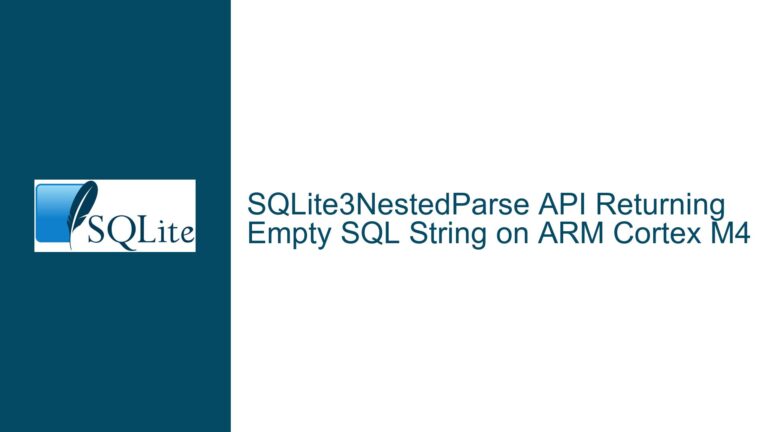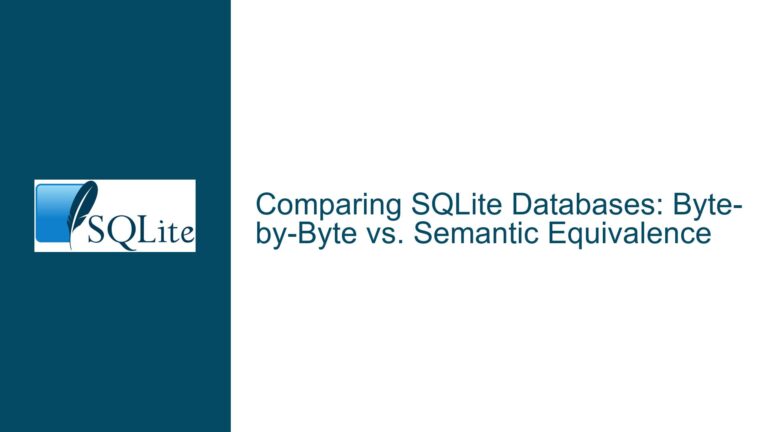Handling Surname “Null” in SQLite: Design Flaws and Solutions
Issue Overview: Confusion Between String "Null" and SQL NULL
The core issue revolves around the confusion between the string literal "Null" and the SQL NULL value, particularly when searching for an employee whose surname is "Null". This problem is not inherently an SQLite issue but rather a symptom of poor application design and middleware assumptions. The confusion arises when middleware layers or application logic incorrectly interpret the string "Null" as the SQL NULL value, leading to application crashes or incorrect query results.
In SQLite, the string "Null" (enclosed in single quotes) is treated as a literal string, while NULL (without quotes) represents the absence of a value. The distinction is clear in SQLite’s query execution, as demonstrated by the following example:
CREATE TABLE T1(c1 TEXT, c2 TEXT);
INSERT INTO T1 VALUES(NULL, 'Null');
SELECT COUNT(*) FROM T1 WHERE c1 IS NULL; -- Returns 1
SELECT COUNT(*) FROM T1 WHERE c2 IS NULL; -- Returns 0
Here, the first query correctly identifies NULL values in column c1, while the second query distinguishes the string "Null" in column c2. However, the problem arises when middleware or application logic fails to maintain this distinction, often due to improper handling of data types or assumptions about the meaning of the string "Null".
Possible Causes: Middleware Assumptions and Poor Design Practices
The root cause of the issue lies in the layers of middleware and application logic that sit between the user interface and the database. These layers often introduce assumptions about data types and values, leading to incorrect interpretations of the string "Null". Below are the primary causes of this issue:
Middleware Misinterpretation of "Null": Middleware layers, such as SOAP web services or XML parsers, may incorrectly interpret the string "Null" as the SQL
NULLvalue. This misinterpretation occurs when the middleware assumes that the string "Null" should be converted to aNULLvalue, rather than treating it as a literal string. This assumption is often hardcoded into the middleware logic, leading to errors when processing data.Lack of Parameter Binding: The application may fail to use parameterized queries or prepared statements, leading to direct string interpolation in SQL queries. When the surname "Null" is interpolated into a query, it may be incorrectly interpreted as the SQL
NULLvalue, especially if the query logic does not properly escape or quote the string. This issue is exacerbated by the lack of input validation and sanitization.Poor Data Type Handling: The application may not properly handle data types when passing data between layers. For example, if the surname "Null" is passed as a string but later interpreted as a
NULLvalue, the application logic may break. This issue is particularly common in dynamically typed languages or when using middleware that does not enforce strict data type checking.Inadequate Error Handling: The application may lack robust error handling mechanisms to detect and handle cases where the string "Null" is misinterpreted. Without proper error handling, the application may crash or produce incorrect results when encountering this edge case.
Design Flaws in Data Representation: The application may use a data representation format (e.g., XML, JSON) that does not clearly distinguish between the string "Null" and the
NULLvalue. This ambiguity can lead to incorrect data interpretation when the data is serialized or deserialized.
Troubleshooting Steps, Solutions & Fixes: Addressing the Root Causes
To resolve the issue of the surname "Null" causing application errors, it is essential to address the root causes outlined above. Below are detailed troubleshooting steps and solutions to ensure that the application correctly handles the string "Null" and avoids confusion with the SQL NULL value.
Middleware Fixes: Ensuring Correct Interpretation of "Null"
The first step is to identify and fix any middleware layers that incorrectly interpret the string "Null" as the SQLNULLvalue. This can be achieved by:- Reviewing Middleware Logic: Examine the middleware code to identify any assumptions about the string "Null". Look for hardcoded logic that converts "Null" to
NULLand remove or modify it to treat "Null" as a literal string. - Adding Data Type Annotations: If the middleware supports data type annotations (e.g., in XML or JSON schemas), explicitly annotate the surname field as a string to prevent misinterpretation.
- Testing Edge Cases: Create test cases that include the surname "Null" and verify that the middleware correctly processes it as a string. Use automated testing tools to ensure that the fix does not introduce new issues.
- Reviewing Middleware Logic: Examine the middleware code to identify any assumptions about the string "Null". Look for hardcoded logic that converts "Null" to
Using Parameterized Queries and Prepared Statements
To prevent SQL injection and ensure correct handling of the surname "Null", the application should use parameterized queries or prepared statements. This approach ensures that the string "Null" is treated as a literal value and not misinterpreted as the SQLNULLvalue. The steps to implement this are:- Refactoring SQL Queries: Replace any direct string interpolation in SQL queries with parameterized queries. For example, instead of:
SELECT * FROM employees WHERE surname = 'Null';Use:
SELECT * FROM employees WHERE surname = ?;And bind the parameter
'Null'at runtime. - Enforcing Prepared Statements: Ensure that all database interactions use prepared statements. This can be enforced through code reviews, static analysis tools, or database access libraries that only support prepared statements.
- Validating Input Data: Implement input validation to ensure that the surname field contains valid string data before binding it to the query. This prevents unexpected data from being passed to the database.
- Refactoring SQL Queries: Replace any direct string interpolation in SQL queries with parameterized queries. For example, instead of:
Improving Data Type Handling
To avoid confusion between the string "Null" and the SQLNULLvalue, the application should enforce strict data type handling. This can be achieved by:- Using Strongly Typed Languages: If possible, use a strongly typed programming language for the application logic. This ensures that data types are explicitly defined and enforced, reducing the risk of misinterpretation.
- Validating Data Types at Layer Boundaries: When data is passed between layers (e.g., from the user interface to the middleware to the database), validate the data type at each boundary. For example, ensure that the surname field is always treated as a string and never converted to
NULL. - Using Data Transfer Objects (DTOs): Implement DTOs to encapsulate data and enforce type safety when passing data between layers. This approach ensures that the surname field is consistently treated as a string.
Enhancing Error Handling
Robust error handling is essential to detect and handle cases where the string "Null" is misinterpreted. The application should:- Log Detailed Error Messages: When an error occurs, log detailed error messages that include the context of the error (e.g., the query being executed, the parameter values). This makes it easier to diagnose and fix issues.
- Implement Fallback Mechanisms: If the application encounters an unexpected error (e.g., due to misinterpretation of "Null"), implement fallback mechanisms to handle the error gracefully. For example, return a default value or display a user-friendly error message.
- Monitor for Edge Cases: Use monitoring tools to detect and alert on edge cases, such as queries that return unexpected results or errors related to the surname "Null".
Redesigning Data Representation
To avoid ambiguity in data representation, the application should use a data format that clearly distinguishes between the string "Null" and theNULLvalue. This can be achieved by:- Using JSON or XML Schemas: Define a schema for the data format (e.g., JSON or XML) that explicitly specifies the data type for each field. For example, in JSON:
{ "surname": { "type": "string", "value": "Null" } }This ensures that the surname field is always treated as a string.
- Avoiding Ambiguous Representations: Avoid using data formats or conventions that can lead to ambiguity. For example, do not use the string "Null" to represent a
NULLvalue in JSON or XML. - Validating Data Representation: Use schema validation tools to ensure that the data conforms to the expected format and data types.
- Using JSON or XML Schemas: Define a schema for the data format (e.g., JSON or XML) that explicitly specifies the data type for each field. For example, in JSON:
Implementing Comprehensive Testing
To ensure that the fixes are effective and do not introduce new issues, the application should undergo comprehensive testing. This includes:- Unit Testing: Write unit tests for all database interactions, including queries that involve the surname "Null". Verify that the queries return the expected results and do not produce errors.
- Integration Testing: Perform integration testing to ensure that the middleware and application logic correctly handle the surname "Null" when passed between layers.
- Edge Case Testing: Test edge cases, such as empty strings, special characters, and other values that could be misinterpreted. Ensure that the application handles these cases correctly.
By following these troubleshooting steps and implementing the recommended solutions, the application can correctly handle the surname "Null" and avoid confusion with the SQL NULL value. This approach not only resolves the immediate issue but also improves the overall design and robustness of the application.






